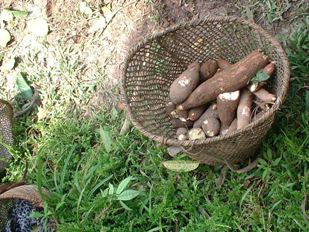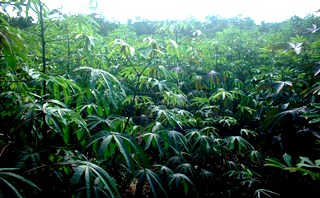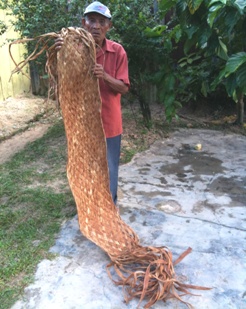A photo from an ancient National Geographic Magazine showed rain forest Indians standing around a long woven tube-like structure.
The tubes are called tipitis (tee-pee-tees) and are used by native people here in eastern Peru to squeeze the cyanide-laden sap from the yuca root.
 A couple of weeks ago my friend Alcides Apuela and I traveled a tributary of the Amazon River looking for dugout canoes. In the afternoon we stopped by a village and made a call at the house of Senora Elsa who had the inside track on the village canoes. The canoe talk went ok, but then I saw a woven article coiled in a burlap bag. It was a tipiti. Elsa was kind enough to unroll the tipiti and I saw it was similar to the one from the old magazine. It was a foot or so wide and about six-feet long with unwoven fibers at each end. This tipiti was woven from the bark of the balsa tree Ochroma pyramidale.
A couple of weeks ago my friend Alcides Apuela and I traveled a tributary of the Amazon River looking for dugout canoes. In the afternoon we stopped by a village and made a call at the house of Senora Elsa who had the inside track on the village canoes. The canoe talk went ok, but then I saw a woven article coiled in a burlap bag. It was a tipiti. Elsa was kind enough to unroll the tipiti and I saw it was similar to the one from the old magazine. It was a foot or so wide and about six-feet long with unwoven fibers at each end. This tipiti was woven from the bark of the balsa tree Ochroma pyramidale.
The root of the yuca plant is crushed, mixed with water and folded into the length of the tipiti. Tightly bound, the tipiti is suspended from a rafter by the end fibers and twisted until the cyanide laden sap is squeezed out.
 The yuca plant, Manihot esculenta, also called cassava, or manioc is a staple in the tropics worldwide. Unfortunately, some older varieties of yuca (appropriately called bitter yuca) contain large amounts of hydrogen cyanide–thus the use of the tipiti for removing the poison.
The yuca plant, Manihot esculenta, also called cassava, or manioc is a staple in the tropics worldwide. Unfortunately, some older varieties of yuca (appropriately called bitter yuca) contain large amounts of hydrogen cyanide–thus the use of the tipiti for removing the poison.
Today, villagers have new “sweet yuca” that is low in cyanide. I see yuca everywhere in the markets and no one seems to worry much about the poison. But travel back into the jungle where tribes grow the old bitter yuca and you’ll still see the odd tipiti in use.
I read somewhere that bitter yuca contains cyanide up to 800 parts per million. That’s about three shot glasses in a barrel and we’re talking cyanide here–the stuff they use for rat poison. So you can see why the tipiti comes into play.
That afternoon at Elsa’s house after some hard negotiating I was able to purchase her tipiti. I wish I could say we toasted the transaction over a cup of traditional maszato made from yuca. Unfortunately, we closed the deal over a warm bottle of Incakola that Elsa sold to me with a handsome markup.
 Back in Iquitos I discovered I hadn’t taken a picture of my prized tipiti. I needed a model, so my old carpenter friend Esteven Mozombite stood in for Elsa.
Back in Iquitos I discovered I hadn’t taken a picture of my prized tipiti. I needed a model, so my old carpenter friend Esteven Mozombite stood in for Elsa.
I’ll probably sell my tipiti, but I hope it doesn’t end up in a singles bar or sport club. It needs to find a home in a good museum display or held by a serious collector proud of its heritage.
If you know about tipitis, share your information with us so we can all understand the history of these interesting tools.
